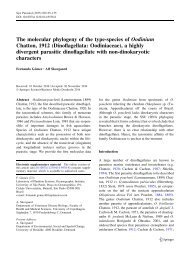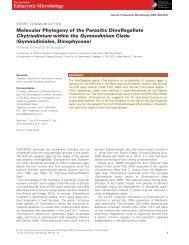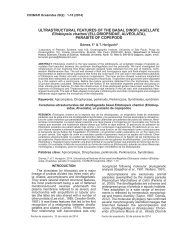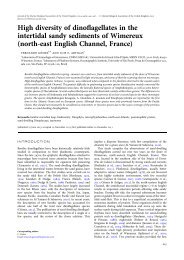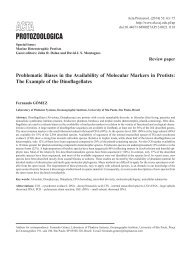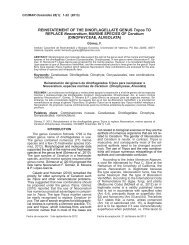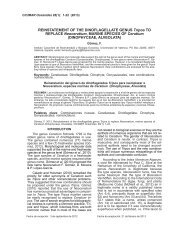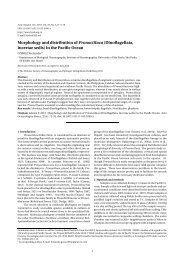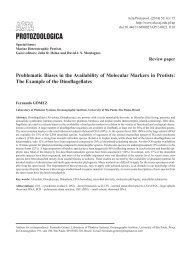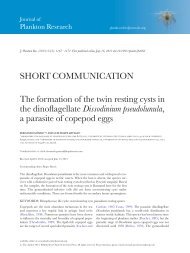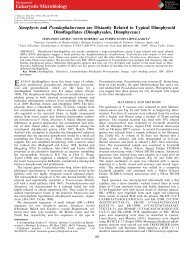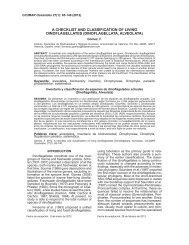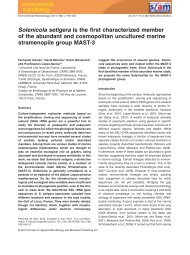A quantitative review of the lifestyle, habitat and trophic diversity of dinoflagellates (Dinoflagellata, Alveolata)
This study reviews the trends in the lifestyle, habitat distribution and trophic diversity of the 2377 described species of dinoflagellates (Dinophyceae). Most of the dinoflagellates inhabit marine waters, whereas 17% of the total species have colonized continental waters. Dinoflagellates are dominated by planktonic species, while benthic forms represented 8% of the species. From the total number of species, 49% are heterotrophic (devoid of plastids), while 51% of the species have been reported with plastids (that does not strictly imply autotrophy). All the basal dinoflagellates (ellobiopsids, Duboscquodinida, Syndiniales) are heterotrophic, with the exception of a few Noctilucales (Spatulodinium). The continental waters are highly dominated by plastid-containing species (88%), while in marine environments there is a slight dominance of heterotrophic species (58%). Most of the dinoflagellates are free-living forms; only 7% of the total species are parasites. The dinokaryotic parasites appear in separate clades, and about 40% of them contain plastids. The beneficial or mutualistic symbionts (21 species, 1%) are photosynthetic species dispersed into at least three clades.
This study reviews the trends in the lifestyle, habitat distribution and trophic diversity of the 2377 described species of
dinoflagellates (Dinophyceae). Most of the dinoflagellates inhabit marine waters, whereas 17% of the total species have
colonized continental waters. Dinoflagellates are dominated by planktonic species, while benthic forms represented 8% of
the species. From the total number of species, 49% are heterotrophic (devoid of plastids), while 51% of the species have
been reported with plastids (that does not strictly imply autotrophy). All the basal dinoflagellates (ellobiopsids,
Duboscquodinida, Syndiniales) are heterotrophic, with the exception of a few Noctilucales (Spatulodinium). The
continental waters are highly dominated by plastid-containing species (88%), while in marine environments there is a slight
dominance of heterotrophic species (58%). Most of the dinoflagellates are free-living forms; only 7% of the total species
are parasites. The dinokaryotic parasites appear in separate clades, and about 40% of them contain plastids. The beneficial
or mutualistic symbionts (21 species, 1%) are photosynthetic species dispersed into at least three clades.
Create successful ePaper yourself
Turn your PDF publications into a flip-book with our unique Google optimized e-Paper software.
Systematics <strong>and</strong> Bio<strong>diversity</strong> (2012), 10(3): 267–275<br />
Perspective<br />
A <strong>quantitative</strong> <strong>review</strong> <strong>of</strong> <strong>the</strong> <strong>lifestyle</strong>, <strong>habitat</strong> <strong>and</strong> <strong>trophic</strong> <strong>diversity</strong><br />
<strong>of</strong> din<strong>of</strong>lagellates (Din<strong>of</strong>lagellata, <strong>Alveolata</strong>)<br />
FERNANDO GÓMEZ<br />
Instituto Cavanilles de Biodiversidad y Biología Evolutiva, Universidad de Valencia, PO Box 22085, 46071 Valencia, Spain<br />
(Received 16 June 2012; revised 8 August 2012; accepted 9 August 2012)<br />
This study <strong>review</strong>s <strong>the</strong> trends in <strong>the</strong> <strong>lifestyle</strong>, <strong>habitat</strong> distribution <strong>and</strong> <strong>trophic</strong> <strong>diversity</strong> <strong>of</strong> <strong>the</strong> 2377 described species <strong>of</strong><br />
din<strong>of</strong>lagellates (Dinophyceae). Most <strong>of</strong> <strong>the</strong> din<strong>of</strong>lagellates inhabit marine waters, whereas 17% <strong>of</strong> <strong>the</strong> total species have<br />
colonized continental waters. Din<strong>of</strong>lagellates are dominated by planktonic species, while benthic forms represented 8% <strong>of</strong><br />
<strong>the</strong> species. From <strong>the</strong> total number <strong>of</strong> species, 49% are hetero<strong>trophic</strong> (devoid <strong>of</strong> plastids), while 51% <strong>of</strong> <strong>the</strong> species have<br />
been reported with plastids (that does not strictly imply autotrophy). All <strong>the</strong> basal din<strong>of</strong>lagellates (ellobiopsids,<br />
Duboscquodinida, Syndiniales) are hetero<strong>trophic</strong>, with <strong>the</strong> exception <strong>of</strong> a few Noctilucales (Spatulodinium). The<br />
continental waters are highly dominated by plastid-containing species (88%), while in marine environments <strong>the</strong>re is a slight<br />
dominance <strong>of</strong> hetero<strong>trophic</strong> species (58%). Most <strong>of</strong> <strong>the</strong> din<strong>of</strong>lagellates are free-living forms; only 7% <strong>of</strong> <strong>the</strong> total species<br />
are parasites. The dinokaryotic parasites appear in separate clades, <strong>and</strong> about 40% <strong>of</strong> <strong>the</strong>m contain plastids. The beneficial<br />
or mutualistic symbionts (21 species, 1%) are photosyn<strong>the</strong>tic species dispersed into at least three clades.<br />
Key words: benthic, bio<strong>diversity</strong>, Dinophyceae, freshwater Dinophyta, heterotrophy, parasite, symbioses, syndineans<br />
Introduction<br />
The din<strong>of</strong>lagellates are an important group <strong>of</strong> protists in<br />
marine <strong>and</strong> freshwaters. Their adaptation to a wide range<br />
<strong>of</strong> environments is reflected by tremendous morphological<br />
<strong>and</strong> <strong>trophic</strong> <strong>diversity</strong> (Taylor, 1987). Like <strong>the</strong>ir alveolate<br />
relatives, apicomplexans <strong>and</strong> ciliates, <strong>the</strong> din<strong>of</strong>lagellate<br />
cortex has a set <strong>of</strong> flattened vesicles referred to as alveoli.<br />
Din<strong>of</strong>lagellates possess a ribbon-like transverse flagellum<br />
encircling <strong>the</strong> cell <strong>and</strong> ano<strong>the</strong>r longitudinal flagellum. For<br />
<strong>the</strong> din<strong>of</strong>lagellate core, <strong>the</strong> nucleus, dinokaryon, contains<br />
large amounts <strong>of</strong> DNA <strong>and</strong> unique cytological features such<br />
as permanently condensed chromosomes <strong>and</strong> a lack <strong>of</strong> typical<br />
eukaryotic histones (Spector, 1984; Lin, 2011). Among<br />
<strong>the</strong> basal din<strong>of</strong>lagellates, <strong>the</strong> syndinian nucleus is much<br />
closer to <strong>the</strong> eukaryotic type. Din<strong>of</strong>lagellates are both primary<br />
producers <strong>and</strong> consumers in <strong>the</strong> food web, sometimes<br />
at <strong>the</strong> same time, <strong>and</strong> best known for <strong>the</strong>ir dominant role in<br />
causing harmful algal blooms. Fur<strong>the</strong>rmore, din<strong>of</strong>lagellates<br />
can be ei<strong>the</strong>r ecto- or endoparasites (Chatton, 1920; Cachon<br />
& Cachon, 1987; Coats, 1999). As mutualistic symbionts,<br />
din<strong>of</strong>lagellates provide essential nutrients to most corals<br />
<strong>and</strong> numerous o<strong>the</strong>r marine invertebrates, supporting coral<br />
Correspondence to: Fern<strong>and</strong>o Gómez. E-mail: fern<strong>and</strong>o.gomez@<br />
fitoplancton.com<br />
reefs, one <strong>of</strong> <strong>the</strong> most diverse ecosystems on Earth (Trench,<br />
1993; LaJeunesse, 2002).<br />
Din<strong>of</strong>lagellates show a high versatility in <strong>the</strong> <strong>habitat</strong><br />
distribution, marine or continental waters, <strong>and</strong> adaptation<br />
to pelagic or benthic environments. They also show a high<br />
<strong>trophic</strong> <strong>diversity</strong> (<strong>review</strong>ed by Gaines & Elbrächter, 1987;<br />
Stoecker, 1999; Hansen, 2011). However, no <strong>review</strong> has<br />
ever reported <strong>the</strong> precise number <strong>of</strong> species associated<br />
with each type <strong>of</strong> <strong>habitat</strong>, <strong>lifestyle</strong> or <strong>trophic</strong> <strong>diversity</strong>.<br />
This analysis <strong>review</strong>s <strong>the</strong>se general trends based on data<br />
<strong>of</strong> each din<strong>of</strong>lagellate species. The aim <strong>of</strong> this study was to<br />
provide a general view <strong>of</strong> <strong>the</strong> <strong>habitat</strong> distribution, <strong>lifestyle</strong><br />
<strong>and</strong> <strong>trophic</strong> <strong>diversity</strong>, using <strong>quantitative</strong> data <strong>of</strong> <strong>the</strong> whole<br />
din<strong>of</strong>lagellate group.<br />
Materials <strong>and</strong> methods<br />
The primary source for analysis is <strong>the</strong> checklist <strong>of</strong> living<br />
din<strong>of</strong>lagellates by Gómez (2012) that listed 2377 described<br />
species. The information on each species has been labelled<br />
according to its <strong>habitat</strong> distribution (marine or continental,<br />
<strong>and</strong> planktonic or benthic), <strong>lifestyle</strong> (free-living, parasitic or<br />
mutualistic symbiont), <strong>and</strong> <strong>trophic</strong> <strong>diversity</strong> (hetero<strong>trophic</strong><br />
<strong>and</strong> plastid-containing). The database is provided (Table<br />
S1, see supplementary material, which is available on <strong>the</strong><br />
ISSN 1477-2000 print / 1478-0933 online<br />
C○ 2012 The Natural History Museum<br />
http://dx.doi.org/10.1080/14772000.2012.721021
268 F. Gómez
Lifestyle, <strong>habitat</strong> <strong>and</strong> <strong>trophic</strong> <strong>diversity</strong> <strong>of</strong> din<strong>of</strong>lagellates 269<br />
Supplementary tab <strong>of</strong> <strong>the</strong> article’s Taylor & Francis Online<br />
page at http://dx.doi/10.1080/14772000.2012.721021).<br />
However, information on a precise species should be<br />
verified in <strong>the</strong> specific literature.<br />
There are no examples <strong>of</strong> din<strong>of</strong>lagellate species which<br />
are able to proliferate in both marine <strong>and</strong> oligohaline continental<br />
waters. However, <strong>the</strong> distinction for marine or continental<br />
species may be difficult for some species described<br />
from estuarine or coastal brackish waters subjected to strong<br />
fluctuations in salinity. At <strong>the</strong>se locations, continental <strong>and</strong><br />
marine species may co-exist. Species described from estuaries<br />
<strong>and</strong> brackish coastal environments (Kryptoperidinium,<br />
Oxyrrhis, Pfiesteria) are labelled as marine species. O<strong>the</strong>r<br />
<strong>habitat</strong> distribution concerns <strong>the</strong> species living in <strong>the</strong> water<br />
column (plankton) or associated with <strong>the</strong> bottom (benthic).<br />
This distinction is not clear-cut because <strong>the</strong> turbulence may<br />
re-suspend <strong>the</strong> benthic species (tychoplankton), <strong>and</strong> planktonic<br />
species have benthic life stages (e.g. cysts). In <strong>the</strong> case<br />
<strong>of</strong> <strong>the</strong> parasites, <strong>the</strong>y are considered planktonic or benthic<br />
according to <strong>the</strong> <strong>habitat</strong> <strong>of</strong> <strong>the</strong>ir hosts, although <strong>the</strong> infecting<br />
dinospores disperse in <strong>the</strong> water column.<br />
The <strong>lifestyle</strong> <strong>of</strong> din<strong>of</strong>lagellates is divided into free-living<br />
<strong>and</strong> symbiotic species. The latter are divided into mutualistic<br />
symbionts (i.e. both organisms benefit), <strong>and</strong> parasites<br />
(<strong>the</strong> din<strong>of</strong>lagellate benefits at <strong>the</strong> expense <strong>of</strong> <strong>the</strong> host). The<br />
distinction between parasitic <strong>and</strong> hetero<strong>trophic</strong> din<strong>of</strong>lagellate<br />
is not immediate. Parasitic din<strong>of</strong>lagellates are considered<br />
those forms that have morphologically different<br />
feeding <strong>and</strong> reproductive stages <strong>and</strong> that produce more<br />
than two daughter cells after each feeding event (Gaines &<br />
Elbrächter, 1987). The din<strong>of</strong>lagellates are considered mutualistic<br />
symbionts when <strong>the</strong> din<strong>of</strong>lagellate is smaller than<br />
<strong>the</strong> host as occurred in corals, various types <strong>of</strong> anemones,<br />
jellyfish <strong>and</strong> molluscs <strong>of</strong> <strong>the</strong> reef, <strong>and</strong> in planktonic Acantharia,<br />
Foraminifera <strong>and</strong> Radiolaria (Spero & Angel, 1991).<br />
In o<strong>the</strong>r cases, <strong>the</strong> din<strong>of</strong>lagellate is larger than <strong>the</strong> symbiont<br />
<strong>and</strong> it acts as a host (as has occurred in some<br />
din<strong>of</strong>lagellate–cyanobacteria consortia). This is not considered<br />
a symbiotic or parasitic relationship, <strong>and</strong> <strong>the</strong> din<strong>of</strong>lagellates<br />
are labelled as free-living hetero<strong>trophic</strong> species.<br />
Din<strong>of</strong>lagellates have been traditionally categorized as auto<strong>trophic</strong><br />
or hetero<strong>trophic</strong>, based on <strong>the</strong> presence or absence<br />
<strong>of</strong> chlorophyll <strong>and</strong> plastids. It is difficult to establish whe<strong>the</strong>r<br />
<strong>the</strong> plastids are sustaining <strong>the</strong> cell independently, since o<strong>the</strong>r<br />
sources <strong>of</strong> carbon, <strong>and</strong> most photosyn<strong>the</strong>tic species relied<br />
on exogenous vitamins (Tang et al., 2010). It has long<br />
been recognized that some photosyn<strong>the</strong>tic din<strong>of</strong>lagellates<br />
have food vacuoles <strong>and</strong> feed on o<strong>the</strong>r protists (Stoecker,<br />
1999; Jeong et al., 2005; Hansen, 2011). For some din<strong>of</strong>lagellates,<br />
it is not clear whe<strong>the</strong>r <strong>the</strong>ir photosyn<strong>the</strong>tic<br />
machinery is ei<strong>the</strong>r <strong>the</strong>ir own or derived from prey, nor<br />
is it clear whe<strong>the</strong>r <strong>the</strong> plastids or endosymbionts need to<br />
be periodically replenished through ingestion (e.g. Dinophysis,<br />
García-Cuetos et al., 2010; Pfiesteria, Feinstein<br />
et al., 2002). The species devoid <strong>of</strong> plastids or pigments<br />
are labelled as ‘hetero<strong>trophic</strong>’. It is more difficult to find<br />
a term for <strong>the</strong> species that possess plastids (auxo<strong>trophic</strong>,<br />
auto<strong>trophic</strong>, mixo<strong>trophic</strong>, photosyn<strong>the</strong>tic). Thus, <strong>the</strong> rest <strong>of</strong><br />
<strong>the</strong> taxa are pooled as ‘plastid-containing’ species. Many<br />
<strong>of</strong> <strong>the</strong> original species descriptions did not specify <strong>the</strong> presence<br />
or absence <strong>of</strong> chloroplasts, or in some cases <strong>the</strong> food<br />
contents were misinterpreted as plastids. This distinction is<br />
subjected to <strong>the</strong> difficulties to determine <strong>the</strong> <strong>trophic</strong> character<br />
<strong>of</strong> numerous species.<br />
Results<br />
Trends in <strong>habitat</strong> distribution<br />
The din<strong>of</strong>lagellates have reached high morphological <strong>diversity</strong><br />
(Fig. 1) <strong>and</strong> show higher species richness in marine<br />
environments. From <strong>the</strong> total <strong>of</strong> 2377 described species <strong>of</strong><br />
din<strong>of</strong>lagellates, 1957 species (82%) were described from<br />
marine waters (including estuaries <strong>and</strong> brackish coastal<br />
environments) (Figs 2–17). Most <strong>of</strong> <strong>the</strong> marine din<strong>of</strong>lagellates<br />
were free-living <strong>and</strong> marine parasites encompassed<br />
137 species (Fig. 3). All <strong>the</strong> described din<strong>of</strong>lagellates living<br />
in beneficial symbiotic consortia were marine (21 species,<br />
1%). Marine din<strong>of</strong>lagellates are dominated by planktonic<br />
species (1787 species, 91%), with 170 benthic species<br />
(9%) (Fig. 16). The number <strong>of</strong> hetero<strong>trophic</strong> species in<br />
marine environments was slightly higher (1131 species,<br />
58%) than for plastid-containing species (Table S2, see<br />
supplementary material, which is available on <strong>the</strong> Supplementary<br />
tab <strong>of</strong> <strong>the</strong> article’s Taylor & Francis Online<br />
←−−−−−−−−−−−−−−−−−−−−−−−−−−−−−−−−−−−−−−−−−−−−−−−−−−−−−−−−−−−−−−−−−−−−−−−−−−−−−−−−−−−−−−−−−−−−−−−−−<br />
Fig. 1. Diversity <strong>of</strong> major lineages <strong>of</strong> din<strong>of</strong>lagellates: 1. Ellobiopsis; 2.Oxyrrhis; 3.Duboscquella; 4.Syndinium; 5.K<strong>of</strong>oidinium;<br />
6. Noctiluca; 7.Spatulodinium; 8.Scaphodinium; 9.Haplozoon; 10. Cryp<strong>the</strong>codinium; 11. Dinothrix; 12. Peridinium quinquecorne;<br />
13. Durinskia; 14. Phytodinium; 15. Cystodinium; 16. Borghiella; 17. Sphaerodinium; 18. Biecheleria. 19. Symbiodinium; 20. Takayama;<br />
21. Karlodinium; 22. Brachidinium; 23. Pseliodinium: 24. Torodinium; 25. Gynogonadinium; 26. Amphidinium; 27. Gymnodinium;<br />
28. Polykrikos; 29. Warnowia; 30. Erythropsidinium; 31. Dissodinium; 32. Chytriodinium; 33. Prorocentrum s.s.; 34. Dinophysis;<br />
35. Citharistes; 36. Histioneis; 37. Parahistioneis; 38. Ornithocercus; 39. Phalacroma; 40. Amphisolenia; 41. Triposolenia; 42.<br />
Sinophysis; 43. Exuviaella/Haplodinium; 44. Peridinium s.s.; 45. Protoperidinium s.s.; 46. Diplopsalis; 47. Thecadinium; 48. Gonyaulax;<br />
49. Spiraulax; 50. Lingulodinium; 51. Amylax; 52. Goniodoma; 53. Gambierdiscus; 54. Ostreopsis; 55. Coolia; 56. Alex<strong>and</strong>rium; 57.<br />
Pyrodinium; 58. Centrodinium; 59. Fragilidium; 60. Pyrophacus; 61. Pyrocystis; 62. Ceratium; 63. Neoceratium; 64. Ceratocorys; 65.<br />
Protoceratium; 66. Schuettiella; 67. Blastodinium; 68. Heterocapsa; 69. Amphidiniopsis; 70. Herdmania; 71. Archaeperidinium; 72.<br />
Podolampas; 73. Blepharocysta; 74. Rosc<strong>of</strong>fia; 75. Lessardia; 76. Heterodinium; 77. Corythodinium; 78. Gyrodinium; 79. Hemidinium;<br />
80. Glenodinium; 81. Pfiesteria; 82. Scrippsiella; 83. Oodinium.
270 F. Gómez<br />
2<br />
3<br />
4<br />
5<br />
PLASTID-<br />
CONTAINING<br />
HETERO-<br />
TROPHIC<br />
FREE-<br />
LIVING<br />
PARASITE<br />
SYMBIOSIS<br />
MARINE<br />
CONTINENTAL<br />
PLANKTON<br />
BENTHIC<br />
6<br />
SYM<br />
PAR<br />
FREE-<br />
LIVING<br />
PARASITE<br />
FREE-<br />
LIVING<br />
FREE<br />
7<br />
HETERO-<br />
TROPHIC<br />
PLASTID-<br />
CONTAINING<br />
FREE-LIVING<br />
HET<br />
PARASITE<br />
8<br />
HETERO-<br />
TROPHIC<br />
MARINE<br />
CHL<br />
PLASTID-<br />
CONTAINING<br />
HET<br />
CONTINENTAL<br />
9<br />
HETERO-<br />
TROPHIC<br />
PLANKTON<br />
PLASTID-<br />
CONTAINING<br />
CHL<br />
HET<br />
BENTHIC<br />
10<br />
plastid-<br />
CONTINENTAL<br />
MARINE<br />
hetero<strong>trophic</strong><br />
CONTINENTAL<br />
MARINE<br />
11<br />
MARINE<br />
CONTINENTAL<br />
MARINE<br />
PARASITE<br />
12<br />
FREE-<br />
LIVING<br />
PARASITE<br />
SYM<br />
FREE-<br />
LIVING<br />
CONTINENTAL<br />
PAR<br />
13<br />
FREE-<br />
LIVING<br />
PARASITE<br />
FRE<br />
BENTHIC<br />
FREE-LIVING<br />
MARINE<br />
PLANKTON<br />
14<br />
plastid-<br />
BENTHIC<br />
PLANKTON<br />
hetero<strong>trophic</strong><br />
BENTHIC<br />
PLANKTON<br />
15<br />
PLANKTON<br />
BENTHIC<br />
PLK<br />
PARASITE<br />
16<br />
BENTHIC<br />
BEN<br />
PLANKTON<br />
PLANKTON<br />
CONTINENTAL<br />
17<br />
CONTINENTAL<br />
MAR<br />
MARINE<br />
CON<br />
BENTHIC<br />
FREE-LIVING<br />
MARINE<br />
PLANKTON<br />
plastid-<br />
hetero<strong>trophic</strong><br />
Figs 2–17. Pie charts <strong>of</strong> <strong>the</strong> percent <strong>of</strong> din<strong>of</strong>lagellates (n = 2377 species) according to <strong>the</strong> <strong>trophic</strong> classification (hetero<strong>trophic</strong> or plastidcontaining<br />
species), <strong>lifestyle</strong> (free-living species, parasites or mutualist symbionts) <strong>and</strong> <strong>habitat</strong> (marine or continental, planktonic or<br />
benthic). CHL: plastid-containing species; HET: hetero<strong>trophic</strong>; FRE: free-living; PAR: parasites; SYM: mutualistic symbionts; MAR:<br />
marine; CON: species living in continental waters; PLK: planktonic, living in <strong>the</strong> water column; BEN: benthic, living in <strong>the</strong> benthos.<br />
page at http://dx.doi/10.1080/14772000.2012.721021). All<br />
<strong>the</strong> basal din<strong>of</strong>lagellates have been described from marine<br />
waters. Among <strong>the</strong> Dinokaryota, <strong>the</strong> order Dinophysales<br />
is exclusively composed <strong>of</strong> marine species,<br />
<strong>and</strong> Prorocentrales <strong>and</strong> Gonyaulacales were highly dominated<br />
by marine species (Table S1, see supplementary<br />
material, which is available on <strong>the</strong> Supplementary<br />
tab <strong>of</strong> <strong>the</strong> article’s Taylor & Francis Online page at<br />
http://dx.doi/10.1080/14772000.2012.721021).<br />
A total <strong>of</strong> 420 species have been described from<br />
continental waters (17% <strong>of</strong> 2377 species) (Fig. 4). A few<br />
freshwater species were benthic (30 species, 7%), mainly<br />
composed <strong>of</strong> a group <strong>of</strong> insufficiently known taxa representing<br />
<strong>the</strong> genera, Cystodinium, Stylodinium <strong>and</strong> Tetradinium.<br />
In contrast to <strong>the</strong> marine species, <strong>the</strong> continental species<br />
were highly dominated by plastid-containing species (88%)<br />
(Fig. 8). The few hetero<strong>trophic</strong> species (48 species, 11%)<br />
were little-known species <strong>of</strong> <strong>the</strong> genera Gymnodinium,<br />
Gyrodinium, Katodinium or Stylodinium. The percentage<br />
<strong>of</strong> parasitic species in continental waters (27 species,<br />
6%) was slightly lower than in marine waters (Fig. 12).<br />
Several genera <strong>of</strong> continental parasites contained plastids
Lifestyle, <strong>habitat</strong> <strong>and</strong> <strong>trophic</strong> <strong>diversity</strong> <strong>of</strong> din<strong>of</strong>lagellates 271<br />
(Cystodinium, Crepidoodinium) <strong>and</strong> o<strong>the</strong>rs were devoid <strong>of</strong><br />
plastids (Cystodinedria, Oodinioides <strong>and</strong> Stylodinium).<br />
Concerning <strong>the</strong> distribution <strong>of</strong> din<strong>of</strong>lagellates in <strong>the</strong><br />
water column, most were planktonic (2177, 91%) (Fig. 5).<br />
These planktonic species were preferentially marine (1787,<br />
91%), <strong>and</strong> about one half contained plastids (Fig. 9). A total<br />
<strong>of</strong> 127 (5%) species were parasites. There were 200 species<br />
described from benthic environments (8% <strong>of</strong> total), mainly<br />
algal epiphytes or s<strong>and</strong>-dwelling species (episammic).<br />
Most <strong>of</strong> <strong>the</strong> benthic species were marine (170 species, 85%)<br />
<strong>and</strong> plastid-containing (133 species, 66%) (Table S2, see<br />
supplementary material, which is available on <strong>the</strong> Supplementary<br />
tab <strong>of</strong> <strong>the</strong> article’s Taylor & Francis Online page<br />
at http://dx.doi/10.1080/14772000.2012.721021). Benthic<br />
species have not been described among basal din<strong>of</strong>lagellates,<br />
with <strong>the</strong> exception <strong>of</strong> Hematodinium, which parasitizes<br />
benthic crustaceans. Among <strong>the</strong> dinokaryonts, <strong>the</strong><br />
order Gonyaulacales showed a high proportion <strong>of</strong> benthic<br />
species due to <strong>the</strong> epiphytic genera, Coolia, Gambierdiscus,<br />
Ostreopsis <strong>and</strong> <strong>the</strong> s<strong>and</strong>-dwelling Thecadinium. The percentage<br />
<strong>of</strong> benthic parasitic species (37 species, 18%) was<br />
higher than for <strong>the</strong> planktonic species. The benthic parasites<br />
belonged to <strong>the</strong> hetero<strong>trophic</strong> genera, Haplozoon <strong>and</strong> Stylodinium,<br />
<strong>and</strong> <strong>the</strong> plastid-containing Cystodinium. Among <strong>the</strong><br />
beneficial symbiotic species, Symbiodinium spp. <strong>and</strong> Amphidinium<br />
belauense are associated with benthic organisms<br />
(Table S1, see supplementary material, which is available on<br />
<strong>the</strong> Supplementary tab <strong>of</strong> <strong>the</strong> article’s Taylor & Francis Online<br />
page at http://dx.doi/10.1080/14772000.2012.721021).<br />
Trends in <strong>the</strong> <strong>lifestyle</strong><br />
The din<strong>of</strong>lagellates are dominated by free-living species<br />
(2192 species, 92%) <strong>of</strong> which 1143 or 52% are plastidcontaining<br />
species (Figs 3, 7). A total <strong>of</strong> 164 din<strong>of</strong>lagellates<br />
species (6.8%) were parasites. About one half <strong>of</strong> <strong>the</strong> parasites<br />
were basal din<strong>of</strong>lagellates (77 species), <strong>and</strong> 87 species<br />
were dinokaryotic parasites. Most <strong>of</strong> <strong>the</strong> parasites were heterotrophs,<br />
with <strong>the</strong> exceptions <strong>of</strong> 34 species that contained<br />
plastids. The main representatives <strong>of</strong> <strong>the</strong> plastid-containing<br />
parasites were Blastodinium, a parasite <strong>of</strong> marine copepods,<br />
Crepidoodinium <strong>and</strong> Piscinoodinium, parasites <strong>of</strong><br />
freshwater fishes, <strong>and</strong> <strong>the</strong> insufficiently known species <strong>of</strong><br />
Cystodinium, a parasite <strong>of</strong> freshwater algae (Table S1,<br />
see supplementary material, which is available on <strong>the</strong> Supplementary<br />
tab <strong>of</strong> <strong>the</strong> article’s Taylor & Francis Online page<br />
at http://dx.doi/10.1080/14772000.2012.721021).<br />
There were 21 species <strong>of</strong> din<strong>of</strong>lagellates living in<br />
a mutually endosymbiotic association. The genus Symbiodinium<br />
with 15 species <strong>and</strong> one species <strong>of</strong> Pelagodinium<br />
(family Symbiodinium) constituted <strong>the</strong> main<br />
clade <strong>of</strong> mutualist symbionts (Table S1, see supplementary<br />
material, which is available on <strong>the</strong> Supplementary<br />
tab <strong>of</strong> <strong>the</strong> article’s Taylor & Francis Online page at<br />
http://dx.doi/10.1080/14772000.2012.721021).<br />
Trends in trophism<br />
The hetero<strong>trophic</strong> species constituted 49% <strong>of</strong> <strong>the</strong> total<br />
species (1179 species) (Fig. 2). They slightly dominate<br />
in marine waters, while <strong>the</strong> proportion was low<br />
in continental waters with only 48 hetero<strong>trophic</strong> species.<br />
Most <strong>of</strong> <strong>the</strong> parasites were hetero<strong>trophic</strong> (130/164 species)<br />
(Fig. 6), <strong>and</strong> about 30% <strong>of</strong> <strong>the</strong> benthic species were hetero<strong>trophic</strong><br />
(67/200 species) (Fig. 14). All <strong>the</strong> basal din<strong>of</strong>lagellates<br />
were heterotrophs, with <strong>the</strong> exception <strong>of</strong><br />
a life stage <strong>of</strong> Spatulodinium, known as Gymnodinium<br />
lebouriae that contained plastids (Table S1, see supplementary<br />
material, which is available on <strong>the</strong> Supplementary<br />
tab <strong>of</strong> <strong>the</strong> article’s Taylor & Francis Online page at<br />
http://dx.doi/10.1080/14772000.2012.721021). Among <strong>the</strong><br />
2280 dinokaryotic din<strong>of</strong>lagellates, 1083 species (48%) are<br />
heterotrophs. None <strong>of</strong> <strong>the</strong> classical major orders (Peridiniales,<br />
Gymnodiniales, Prorocentrales, Dinophysales,<br />
Gonyaulacales) is exclusively constituted <strong>of</strong> hetero<strong>trophic</strong><br />
species. Most <strong>of</strong> Dinophysales were hetero<strong>trophic</strong>, with <strong>the</strong><br />
exception <strong>of</strong> some Dinophysis <strong>and</strong> a few Phalacroma.Several<br />
families <strong>of</strong> Peridiniales sensu lato were exclusively<br />
hetero<strong>trophic</strong> species such as Amphidiniopsidaceae, Heterodiniaceae,<br />
Podolampadaceae <strong>and</strong> Protoperidiniaceae. In<br />
contrast, <strong>the</strong> orders Brachidiniales <strong>and</strong> Prorocentrales were<br />
exclusively composed <strong>of</strong> plastid-containing species, as well<br />
as <strong>the</strong> families Dinotrichaceae, Glenodiniaceae, Heterocapsaceae,<br />
Peridiniaceae sensu stricto <strong>and</strong> Symbiodiniaceae<br />
(Table S1, see supplementary material, which is available on<br />
<strong>the</strong> Supplementary tab <strong>of</strong> <strong>the</strong> article’s Taylor & Francis Online<br />
page at http://dx.doi/10.1080/14772000.2012.721021).<br />
Discussion<br />
Trends in <strong>the</strong> <strong>habitat</strong> distribution<br />
Most major microbial lineages originated in ancient oceans<br />
(e.g. Cavalier-Smith, 2006). Din<strong>of</strong>lagellates show a higher<br />
species richness in marine environments (four <strong>of</strong> each five<br />
species). Bourrelly (1970) <strong>and</strong> Taylor (1987, p. 409) reported<br />
that approximately only 220 species inhabit freshwater<br />
environments. This study listed 420 species living<br />
in continental waters. The proportion <strong>of</strong> marine species<br />
could be higher because: (1) for species descriptions, <strong>the</strong><br />
continental waters have been historically more investigated<br />
than <strong>the</strong> oceans; (2) it could be an excess <strong>of</strong> species described<br />
for several freshwater genera such as Cystodinium,<br />
Hemidinium or Tetradinium because <strong>the</strong>y may correspond<br />
to life stages <strong>of</strong> o<strong>the</strong>r known species (i.e. Baumeister, 1957;<br />
Skvortzov, 1968), as well as many insufficiently known<br />
freshwater species <strong>of</strong> Amphidinium <strong>and</strong> Gymnodinium;<br />
<strong>and</strong> (3) environmental sequencing <strong>of</strong> <strong>the</strong> deep open ocean<br />
or deep sediments revealed numerous novel hetero<strong>trophic</strong><br />
clades din<strong>of</strong>lagellates, that have not been morphologically<br />
characterized (López-García et al., 2001, 2007). They are
272 F. Gómez<br />
<strong>of</strong>ten in smaller size fractions (
Lifestyle, <strong>habitat</strong> <strong>and</strong> <strong>trophic</strong> <strong>diversity</strong> <strong>of</strong> din<strong>of</strong>lagellates 273<br />
The basal din<strong>of</strong>lagellates are considerably dominated by<br />
parasites, while <strong>the</strong> proportion <strong>of</strong> parasites is low (3%)<br />
among <strong>the</strong> typical din<strong>of</strong>lagellates. The parasitism in dinokaryotes<br />
is restricted to 87 species which were <strong>of</strong>ten<br />
dispersed among free-living species. Haplozoon is a parasite<br />
with a basal position in <strong>the</strong> dinokaryotic core (Cachon<br />
& Cachon, 1987). However, <strong>the</strong> o<strong>the</strong>r clades <strong>of</strong> parasitic<br />
din<strong>of</strong>lagellates (Chytriodiniaceae, Oodiniaceae, Piscinoodinium)<br />
emerge among free-living forms, <strong>and</strong> suggest that<br />
parasitism is a recent acquisition. So far, <strong>the</strong> parasitic basal<br />
din<strong>of</strong>lagellates do not contain plastids, while about 40%<br />
<strong>of</strong> <strong>the</strong> dinokaryotic parasites contain plastids. Nearly all<br />
<strong>the</strong> species <strong>of</strong> Blastodinium contain plastids, although <strong>the</strong><br />
photosyn<strong>the</strong>sis partially covers <strong>the</strong> cell requirements <strong>and</strong><br />
<strong>the</strong> rest being ensured by <strong>the</strong> assimilation <strong>of</strong> host digestive<br />
substances (Pasternak et al., 1984). The parasites <strong>of</strong><br />
<strong>the</strong> family Chytriodiniaceae (Chytriodinium, Dissodinium)<br />
emerged among clades <strong>of</strong> photosyn<strong>the</strong>tic species <strong>of</strong> Gymnodinium.<br />
The parasite <strong>of</strong> copepod eggs, Dissodinium pseudolunula,<br />
possesses plastids, while its closer relatives are<br />
hetero<strong>trophic</strong> species (Gómez et al., 2009c). This suggests<br />
a recent loss <strong>of</strong> <strong>the</strong> plastids in Chytriodiniaceae, more than<br />
a recent acquisition in D. pseudolunula. The presence <strong>of</strong><br />
plastids seems to be a reminiscent <strong>of</strong> its photosyn<strong>the</strong>tic<br />
ancestor in Dissodinium <strong>and</strong> Blastodinium, <strong>the</strong> latter with<br />
a peridinioid ancestor (Skovgaard et al., 2007). The phototrophy<br />
may be primarily a mechanism to increase survival<br />
during dispersal <strong>of</strong> <strong>the</strong> infective spores.<br />
The richness <strong>of</strong> parasites in continental waters is relatively<br />
low, <strong>and</strong> in general freshwater parasites are less harmful<br />
than marine ones. Cystodinedria, Cystodinium <strong>and</strong> Stylodinium<br />
appear to rely on photosyn<strong>the</strong>sis during much <strong>of</strong><br />
<strong>the</strong>ir life cycle <strong>and</strong> were long believed to be strict autotrophs<br />
(Cachon & Cachon, 1987; Popovský & Pfiester, 1990). The<br />
number <strong>of</strong> species <strong>of</strong> freshwaters parasites could be overestimated,<br />
because numerous life stages <strong>of</strong> known species<br />
may have been described as separate species. Crepidoodinium<br />
spp. cause little damage to <strong>the</strong>ir hosts <strong>and</strong> may<br />
be ectocommensals, ra<strong>the</strong>r than true parasites (Lom et al.,<br />
1993). The plastid-containing parasite Piscinoodinium belongs<br />
to <strong>the</strong> main clade <strong>of</strong> mutualist symbionts (Symbiodinium)<br />
(Siano et al., 2010).<br />
The number <strong>of</strong> mutualist symbiotic species (21 species,<br />
274 F. Gómez<br />
din<strong>of</strong>lagellates is underestimated. The coloured din<strong>of</strong>lagellates<br />
have received more attention, especially those responsible<br />
for red-tides. The high availability <strong>of</strong> material from<br />
<strong>the</strong> red tide species or <strong>the</strong> possibility to establish cultures<br />
allow detailed morphological, ultrastructural <strong>and</strong> molecular<br />
phylogeny studies. In contrast, <strong>the</strong> hetero<strong>trophic</strong> species<br />
are less visible, <strong>and</strong> usually <strong>the</strong> scarce material available<br />
restricts <strong>the</strong> species description.<br />
Consequently, our knowledge <strong>of</strong> <strong>the</strong> din<strong>of</strong>lagellate is<br />
highly heterogeneous. Because <strong>of</strong> <strong>the</strong>ir ecological <strong>and</strong> evolutionary<br />
importance, din<strong>of</strong>lagellates have a relatively welldeveloped<br />
taxonomy for certain groups such as <strong>the</strong> toxic<br />
species <strong>of</strong> Gonyaulacales (Alex<strong>and</strong>rium), <strong>and</strong> o<strong>the</strong>rs (Symbiodinium).<br />
A greater effort is needed to investigate <strong>the</strong><br />
unknown <strong>diversity</strong>, especially at greater ocean depths <strong>and</strong><br />
<strong>the</strong> deep-ocean floor.<br />
Acknowledgements<br />
F.G. is supported by <strong>the</strong> contract JCI-2010-08492 <strong>of</strong> <strong>the</strong><br />
Ministerio Español de Ciencia y Tecnología.<br />
References<br />
BALECH, E. 1956. Étude des din<strong>of</strong>lagellés du sable de Rosc<strong>of</strong>f.<br />
Revue Algologique, n. ser. 2, 29–52.<br />
BAUMEISTER, W. 1957. Neue Dinococcalen aus dem niederbayerischen<br />
Hiigell<strong>and</strong> zwischen Isar und Inn (I). Archiv für Protistenkunde<br />
102, 21–43.<br />
BOURRELLY, P. 1970. Les algues d’eau douce. Initiation àla<br />
systématique. Tome III: Les algues bleues et rouges. Les<br />
Eugléniens, Peridiniens et Cryptomonadines. Éditions N.<br />
Boubée et Cie, Paris.<br />
BRIDGEMAN, T.B., MESSICK,G.&VANDERPLOEG, H.A. 2000. Sudden<br />
appearance <strong>of</strong> cysts <strong>and</strong> ellobiopsid parasites on zooplankton<br />
in a Michigan Lake: a potential explanation <strong>of</strong> tumorlike<br />
anomalies. Canadian Journal <strong>of</strong> Fisheries <strong>and</strong> Aquatic<br />
Sciences 57, 1539–1544.<br />
CACHON, J.&CACHON, M. 1987. Parasitic din<strong>of</strong>lagellates. In:<br />
TAYLOR, F.J.R., Ed., The Biology <strong>of</strong> Din<strong>of</strong>lagellates. Blackwell<br />
Scientific Publications, Oxford, pp. 571–610.<br />
CAVALIER-SMITH, T. 2006. Cell evolution <strong>and</strong> Earth history: stasis<br />
<strong>and</strong> revolution. Philosophical Transactions <strong>of</strong> <strong>the</strong> Royal<br />
Society Biological Sciences 361, 969–1006.<br />
CHATTON, É. 1920. Les Péridiniens parasites: morphologie, reproduction,<br />
éthologie. Archives de Zoologie Expérimentale et<br />
Générale 59, 1–475.<br />
COATS, D.W. 1999. Parasitic life styles <strong>of</strong> marine din<strong>of</strong>lagellates.<br />
Journal <strong>of</strong> Eukaryotic Microbiology 46, 402–409.<br />
DREBES, G. 1984. Life cycle <strong>and</strong> host specificity <strong>of</strong> marine parasitic<br />
dinophytes. Helgoländer Meeresuntersuchungen 37,<br />
603–622.<br />
FARNELID, H.,TARANGKOON, W.,HANSEN, G.,HANSEN, P.J.&<br />
RIEMANN, L. 2010. Putative N 2 -fixing hetero<strong>trophic</strong> bacteria<br />
associated with din<strong>of</strong>lagellate–Cyanobacteria consortia in<br />
<strong>the</strong> low-nitrogen Indian Ocean. Aquatic Microbial Ecology<br />
61, 105–117.<br />
FEINSTEIN, T.N., TRASLAVINA, R.,SUN, M.-Y.&LIN, S. 2002. Effects<br />
<strong>of</strong> light on photosyn<strong>the</strong>sis, grazing, <strong>and</strong> population dynamics<br />
<strong>of</strong> <strong>the</strong> hetero<strong>trophic</strong> din<strong>of</strong>lagellate Pfiesteria piscicida<br />
(Dinophyceae). Journal <strong>of</strong> Phycology 38, 659–669.<br />
FOSTER, R.A., COLLIER, J.L.&CARPENTER, E.J. 2006. Reverse<br />
transcription PCR amplification <strong>of</strong> cyanobacterial symbiont<br />
16S rRNA sequences from single non-photosyn<strong>the</strong>tic eukaryotic<br />
marine planktonic host cells. Journal <strong>of</strong> Phycology 42,<br />
243–250.<br />
GAINES, G.&ELBRÄCHTER, M. 1987. Hetero<strong>trophic</strong> nutrition. In:<br />
TAYLOR, F.J.R., Ed., The Biology <strong>of</strong> Din<strong>of</strong>lagellates. Blackwell<br />
Scientific Publications, Oxford, pp. 224–268.<br />
GARCÍA-CUETOS, L.,MOESTRUP, Ø.,HANSEN, P.J.&DAUGBJERG,<br />
N. 2010. The toxic din<strong>of</strong>lagellate Dinophysis acuminata harbors<br />
permanent chloroplasts <strong>of</strong> cryptomonad origin, not kleptochloroplasts.<br />
Harmful Algae 9, 25–38.<br />
GÓMEZ, F. 2012. A checklist <strong>and</strong> classification <strong>of</strong> living din<strong>of</strong>lagellates<br />
(Din<strong>of</strong>lagellata, <strong>Alveolata</strong>). CICIMAR Oceánides 27,<br />
65–140.<br />
GÓMEZ, F.,LÓPEZ-GARCÍA, P.&MOREIRA, D. 2009a. Molecular<br />
phylogeny <strong>of</strong> <strong>the</strong> ocelloid-bearing din<strong>of</strong>lagellates Erythropsidinium<br />
<strong>and</strong> Warnowia (Warnowiaceae, Dinophyceae). Journal<br />
<strong>of</strong> Eukaryotic Microbiology 56, 440–445.<br />
GÓMEZ, F.,LÓPEZ-GARCÍA, P.,NOWACZYK, A.&MOREIRA, D.<br />
2009b. The crustacean parasites Ellobiopsis Caullery, 1910<br />
<strong>and</strong> Thalassomyces Niezabitowski, 1913 form a monophyletic<br />
divergent clade within <strong>the</strong> <strong>Alveolata</strong>. Systematic Parasitology<br />
74, 65–74.<br />
GÓMEZ, F.,MOREIRA, D.&LÓPEZ-GARCÍA, P. 2009c. Life cycle<br />
<strong>and</strong> molecular phylogeny <strong>of</strong> <strong>the</strong> din<strong>of</strong>lagellates Chytriodinium<br />
<strong>and</strong> Dissodinium, ectoparasites <strong>of</strong> copepod eggs. European<br />
Journal <strong>of</strong> Protistology 45, 260–270.<br />
GÓMEZ,F.,MOREIRA,D.&LÓPEZ-GARCÍA, P. 2010a. Neoceratium<br />
gen. nov., a new genus for all marine species currently assigned<br />
to Ceratium (Dinophyceae). Protist 161, 35–54.<br />
GÓMEZ, F.,MOREIRA, D.&LÓPEZ-GARCÍA, P. 2010b. Molecular<br />
phylogeny <strong>of</strong> noctilucoid din<strong>of</strong>lagellates (Noctilucales, Dinophyta).<br />
Protist 161, 466–478.<br />
GUILLOU, L., VIPREY, M., CHAMBOUVET, A., WELSH, R.M.,<br />
KIRKHAM, A.R., MASSANA, R.,SCANLAN, D.J.&WORDEN,<br />
A.Z. 2008. Widespread occurrence <strong>and</strong> genetic <strong>diversity</strong><br />
<strong>of</strong> marine parasitoids belonging to Syndiniales (<strong>Alveolata</strong>).<br />
Environmental Microbiology 10, 3349–3365.<br />
HACKETT, J.D., ANDERSON, D.M., ERDNER,D.L.&BHATTACHARYA,<br />
D. 2004. Din<strong>of</strong>lagellates: A remarkable evolutionary experiment.<br />
American Journal <strong>of</strong> Botany 91, 1523–1534.<br />
HANSEN, P.J. 2011. The role <strong>of</strong> photosyn<strong>the</strong>sis <strong>and</strong> food uptake for<br />
<strong>the</strong> growth <strong>of</strong> marine mixo<strong>trophic</strong> din<strong>of</strong>lagellates. Journal <strong>of</strong><br />
Eukaryotic Microbiology 58, 203–214.<br />
HERDMAN, E.C. 1924. Notes on din<strong>of</strong>lagellates <strong>and</strong> o<strong>the</strong>r<br />
organisms causing discolouration <strong>of</strong> <strong>the</strong> s<strong>and</strong> at Port<br />
Erin. IV. Transactions <strong>of</strong> <strong>the</strong> Liverpool Biological Society<br />
38, 75–84.<br />
JEONG, H.J., YEONG, D.Y., PARK, J.Y., SONG, J.Y., KIM, S.T., LEE,<br />
S.H., KIM, K.Y.&YIH, W.H. 2005. Feeding by photo<strong>trophic</strong><br />
red-tide din<strong>of</strong>lagellates: five species newly revealed <strong>and</strong> six<br />
species previously known to be mixo<strong>trophic</strong>. Aquatic Microbial<br />
Ecology 40, 133–150.<br />
LAJEUNESSE, T. 2002. Diversity <strong>and</strong> community structure <strong>of</strong> symbiotic<br />
din<strong>of</strong>lagellates from Caribbean coral reefs. Marine Biology<br />
141, 387–400.<br />
LAJEUNESSE, T.C., LAMBERT, G.,ANDERSON, R.A., COFFROTH,<br />
M.A. & GALBRAITH, D.W. 2005. Symbiodinium (Pyrrhophyta)<br />
genome sizes (DNA content) are smallest among din<strong>of</strong>lagellates.<br />
Journal <strong>of</strong> Phycology 41, 880–886.<br />
LIN, S. 2011. Genomic underst<strong>and</strong>ing <strong>of</strong> din<strong>of</strong>lagellates. Research<br />
in Microbiology 162, 551–569.<br />
LOGARES, R., SHALCHIAN-TABRIZI, K., BOLTOVSKOY, A. &<br />
RENGEFORS, K. 2007. Extensive din<strong>of</strong>lagellate phylogenies
Lifestyle, <strong>habitat</strong> <strong>and</strong> <strong>trophic</strong> <strong>diversity</strong> <strong>of</strong> din<strong>of</strong>lagellates 275<br />
indicate infrequent marine-freshwater transitions. Molecular<br />
Phylogenetics <strong>and</strong> Evolutioin 45, 887–890.<br />
LOM, J.,ROHDE, K.&DYKOVÁ, I. 1993. Crepidoodinium australe<br />
n. sp., an ectocomensal din<strong>of</strong>lagellate from <strong>the</strong> gills <strong>of</strong> Sillago<br />
ciliata an estuarine fish from <strong>the</strong> New South Wales coast <strong>of</strong><br />
Australia. Diseases <strong>of</strong> Aquatic Organisms 15, 63–72.<br />
LÓPEZ-GARCÍA, P., RODRÍGUEZ-VALERA, F., PEDRÓS-ALIÓ, C.<br />
& MOREIRA, D. 2001. Unexpected <strong>diversity</strong> <strong>of</strong> small<br />
eukaryotes in deep-sea Antarctic phytoplankton. Nature 409,<br />
603–607.<br />
LÓPEZ-GARCÍA, P., VERESHCHAKA, A. & MOREIRA, D. 2007.<br />
Eukaryotic <strong>diversity</strong> associated with carbonates <strong>and</strong><br />
fluid–seawater interface in Lost City hydro<strong>the</strong>rmal field.<br />
Environmental Microbiology 9, 546–554.<br />
MANCA, M.,CARNOVALE, A.&ALEMANI, P. 2004. Exotopic protrusions<br />
<strong>and</strong> ellobiopsid infection in zooplanktonic copepods<br />
<strong>of</strong> a large, deep subalpine lake, Lago Maggiore, in nor<strong>the</strong>rn<br />
Italy. Journal <strong>of</strong> Plankton Research 26, 1257–1263.<br />
MCNALLY, K.L., GOVIND, N.S., THOME, P.E.&TRENCH, R.K.<br />
1994. Small-subunit ribosomal DNA sequence analyses <strong>and</strong><br />
a reconstruction <strong>of</strong> <strong>the</strong> inferred phylogeny among symbiotic<br />
din<strong>of</strong>lagellates (Pyrrophyta). Journal <strong>of</strong> Phycology 30,<br />
316–329.<br />
MOREIRA, D. & LÓPEZ-GARCÍA, P. 2003. Are hydro<strong>the</strong>rmal<br />
vents oases for parasitic protists? Trends in Parasitology 19,<br />
556–558.<br />
MORSE, D.,SALOIS, P.,MARKOVIC, P.&HASTINGS, J.W. 1995. A<br />
nuclear-encoded form II RuBisCO in din<strong>of</strong>lagellates. Science<br />
268, 1622–1624.<br />
NISHITANI, G., NAGAI, S., HAYAKAWA, S., KOSAKA, Y.,<br />
SAKURADA, K.,KAMIYAMA, T.&GOJOBORI, T. 2012. Multiple<br />
plastids collected by <strong>the</strong> din<strong>of</strong>lagellate Dinophysis mitra<br />
through kleptoplastidy. Applied <strong>and</strong> Environmental Microbiology<br />
78, 813–821.<br />
PASTERNAK, A.F., ARASHKEVICH,Y.G.&SOROKIN, Y.S. 1984. The<br />
role <strong>of</strong> <strong>the</strong> parasitic algal genus Blastodinium in <strong>the</strong> ecology<br />
<strong>of</strong> planktic copepods. Oceanology 24, 748–751.<br />
POPOVSKÝ, J.&PFIESTER, L.A. 1990. Dinophyceae (Din<strong>of</strong>lagellida).<br />
In: ETTL,H.,GERLOFF,J.,HEYNIG,H.&MOLLENHAUER,<br />
D., Eds., Süsswasserflora von Mitteleuropa. Vol. 6. Gustav<br />
Fischer, Jena <strong>and</strong> Stuttgart, pp. 1–272.<br />
SALDARRIAGA, J.F., TAYLOR, F.J., KEELING,P.J.&CAVALIER-SMITH,<br />
T. 2001. Din<strong>of</strong>lagellate nuclear SSU rRNA phylogeny suggests<br />
multiple plastid losses <strong>and</strong> replacements. Journal <strong>of</strong><br />
Molecular Evolution 53, 204–213.<br />
SALDARRIAGA, J.F., MCEWAN, M.L., FAST, N.M., TAYLOR, F.J.R. &<br />
KEELING, P.J. 2003. Multiple protein phylogenies show<br />
that Oxyrrhis marina <strong>and</strong> Perkinsus marinus are early<br />
branches <strong>of</strong> <strong>the</strong> din<strong>of</strong>lagellate lineage. International Journal<br />
<strong>of</strong> Systematic <strong>and</strong> Evolutionary Microbiology 53,<br />
355–365.<br />
SIANO, R.,MONTRESOR, M.,PROBERT, I.,NOT, F.&DE VARGAS,<br />
C. 2010. Pelagodinium gen. nov. <strong>and</strong> P. beii comb. nov., a<br />
din<strong>of</strong>lagellate symbiont <strong>of</strong> planktonic foraminifera. Protist<br />
161, 385–399.<br />
SKOVGAARD, A.,MASSANA, R.,BALAGUÉ, V.&SAIZ, E. 2005.<br />
Phylogenetic position <strong>of</strong> <strong>the</strong> copepod-infesting parasite<br />
Syndinium turbo (Din<strong>of</strong>lagellata, Syndinea). Protist 156,<br />
413–423.<br />
SKOVGAARD, A., MASSANA, R. & SAIZ, E. 2007. Parasitic<br />
species <strong>of</strong> <strong>the</strong> genus Blastodinium (Blastodiniphyceae)<br />
are peridinioid din<strong>of</strong>lagellates. Journal <strong>of</strong> Phycology 43,<br />
553–560.<br />
SKVORTZOV, B.V. 1968. New <strong>and</strong> little known Peridineae from<br />
nor<strong>the</strong>rn Manchuria, China. Quarterly Journal <strong>of</strong> <strong>the</strong> Taiwan<br />
Museum 21, 79–114.<br />
SPECTOR, D.L., Ed. 1984. Din<strong>of</strong>lagellates. Academic Press,<br />
New York.<br />
SPERO, H.J.&ANGEL, D.L. 1991. Planktonic sarcodines: Microhobitat<br />
for oceanic din<strong>of</strong>lagellates. Journal <strong>of</strong> Phycology 27,<br />
185–195.<br />
STOECKER, D.K. 1999. Mixotrophy among din<strong>of</strong>lagellates. Journal<br />
<strong>of</strong> Eukaryotic Microbiology 46, 397–401.<br />
TAKANO,Y.,HANSEN,G.,FUJITA,D.&HORIGUCHI, T. 2008. Serial<br />
replacement <strong>of</strong> diatom endosymbionts in two freshwater din<strong>of</strong>lagellates,<br />
Peridiniopsis spp. (Peridiniales, Dinophyceae).<br />
Phycologia 47, 41–53.<br />
TANG, E.P.Y. 1996. Why do din<strong>of</strong>lagellates have lower growth<br />
rates? Journal <strong>of</strong> Phycology 32, 80–84.<br />
TANG, Y.Z., KOCH, F.&GOBLER, C.J. 2010. Most harmful algal<br />
bloom species are vitamin B 1 <strong>and</strong> B 12 auxotrophs. Proceedings<br />
<strong>of</strong> <strong>the</strong> National Academy <strong>of</strong> Sciences USA 107,<br />
20756–20761.<br />
TARANGKOON, W.,HANSEN, P.J.&HANSEN, G. 2010. Spatial distribution<br />
<strong>of</strong> symbiont bearing din<strong>of</strong>lagellates in <strong>the</strong> Indian<br />
Ocean in relation to oceanographic regimes. Aquatic Microbial<br />
Ecology 58, 197–213.<br />
TAYLOR, F.J.R., Ed. 1987. The Biology <strong>of</strong> Din<strong>of</strong>lagellates. Blackwell<br />
Scientific Publications, Oxford.<br />
TAYLOR, F.J.R., HOPPENRATH, M.&SALDARRIAGA, J.F. 2008. Din<strong>of</strong>lagellate<br />
<strong>diversity</strong> <strong>and</strong> distribution. Bio<strong>diversity</strong> <strong>and</strong> Conservation<br />
17, 407–418.<br />
TRENCH, R.K. 1993. Microalgal–invertebrate symbioses: a <strong>review</strong>.<br />
Endocytobiosis Cell Research 9, 135–175.<br />
YAMAGUCHI, H.,NAKAYAMA, T.,KAI, A.&INOUYE, I. 2011. Taxonomy<br />
<strong>and</strong> phylogeny <strong>of</strong> a new kleptoplastidal din<strong>of</strong>lagellate,<br />
Gymnodinium myriopyrenoides sp. nov. (Gymnodiniales,<br />
Dinophyceae), <strong>and</strong> its cryptophyte symbiont. Protist 162,<br />
650–667.<br />
ZHANG,H.,CAMPBELL, D.A., STURM, N.R., DUNGAN,C.F.&LIN,S.<br />
2011. Spliced leader RNAs, mitochondrial gene frameshifts<br />
<strong>and</strong> multi-protein phylogeny exp<strong>and</strong> support for <strong>the</strong> genus<br />
Perkinsus as a unique group <strong>of</strong> Alveolates. PLoS ONE 6(5),<br />
e19933.<br />
Associate Editor: Elliot Shubert



